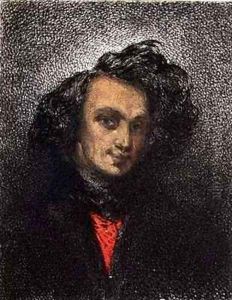Gautier, Theophile Paintings
Théophile Gautier was a French poet, dramatist, novelist, journalist, and art critic who was a prominent figure in the French literary scene of the 19th century. Born on August 30, 1811, in Tarbes, in the Midi-Pyrénées region of France, Gautier moved with his family to Paris in 1814, where he would spend most of his life. Initially, he studied painting before turning to writing, a medium through which he felt he could more freely express his ideas and artistic sensibilities.
Gautier started his literary career as a poet, with his first collection of poems, 'Albertus', being published in 1832. However, he gained real notoriety with the preface to his 1835 novel 'Mademoiselle de Maupin', which served as a manifesto for the burgeoning aesthetic movement known as 'Art for art's sake', which advocated that the value of art lies in its beauty and form rather than its moral or educational content.
Throughout his life, Gautier wrote prolifically across various genres. His best-known works include the novel 'The Romance of a Mummy' (1858), which reflects his fascination with the exotic and the supernatural, and 'Emaux et Camées' (1852), a collection of lyric poems that showcase his technical mastery and preoccupation with perfection of form. His ballet 'Giselle', created in 1841, remains a staple of the classical ballet repertoire to this day.
Apart from his literary endeavors, Gautier was also an influential art critic. He championed the works of Romantic artists such as Eugène Delacroix and Gustave Doré, and his art criticism was collected in several volumes, including 'Les Beaux-Arts en Europe' (1855). He was also a regular contributor to various journals and newspapers, such as 'La Presse' and 'Le Moniteur universel', where he covered art, theatre, and travel.
Théophile Gautier's work had a significant impact on the Parnassian poets and the Symbolist movement. His emphasis on formal perfection and artistic beauty influenced a generation of poets, including Charles Baudelaire, who dedicated his famous volume of poetry 'Les Fleurs du mal' to Gautier.
Gautier died on October 23, 1872, in Neuilly-sur-Seine, near Paris. His legacy as a writer and critic endures, and he is remembered as a central figure in the French literary canon, whose work bridged the gap between Romanticism and Modernism. His insistence on the autonomy of art continues to resonate with artists and writers to this day.
